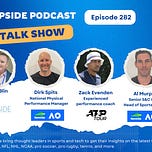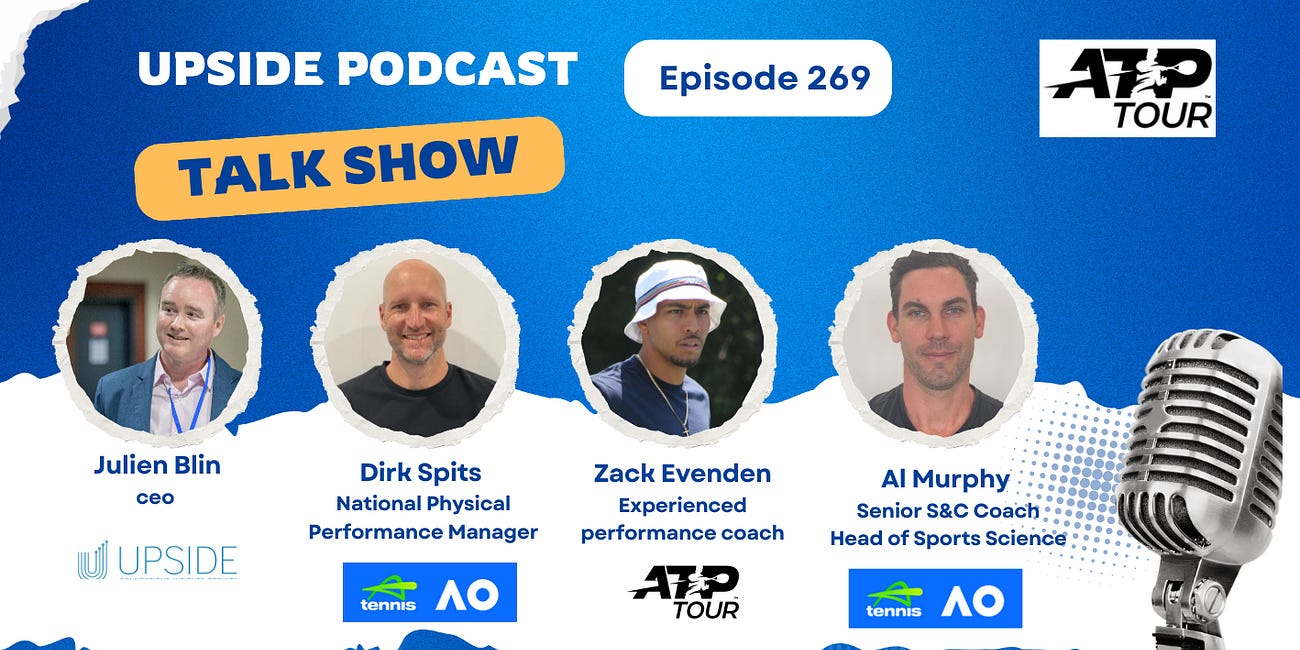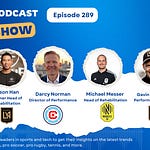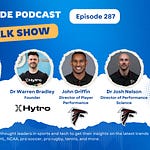This week we had the honor to interview a group of ATP sports performance experts in pro tennis.
Al Murphy, senior S&C coach at Tennis Australia. Al works with tennis players such as Rinky Hijikata, Emerson Jones and Aleks Vukic. He is also the head of sports science at Tennis Australia.
Zack Evenden, an experienced performance coach. Zack has worked with top tennis players like Frances Tiafoe, and Michael Mmoh.
Dirk Spits, the National Physical Performance Manager at Tennis Australia. Dirk works with pro tennis players such as James Duckworth, and Ajla Tomljanovic.
You can watch the video interview below by clicking on the Youtube link. You can also listen to the audio interview by clicking on the link at the top of the page:
📝Show Notes: Through this interview, we touched on the following topics:
Q1. Women’s Tennis & Gender-Specific Research
Are we seeing more tailored training, recovery, and injury-prevention approaches for women athletes, and where is the research still lacking?Q2. Longevity & Aging Athletes
With players competing effectively into their late 30s and even 40s, what adjustments in training load, recovery, and nutrition are proving most impactful for extending careers?Q3. Travel, Jet Lag & Scheduling
Given the relentless global calendar, how are teams using sleep science, circadian rhythm tools, or wearable data to minimize the impact of jet lag and travel fatigue on performance?
Here are some of the best quotes of our conversation with them:
Q1. Women’s Tennis & Gender-Specific Research
Al Murphy:
“From the research perspective, absolutely there are still big gaps in the literature—not just in tennis, but in sport and exercise science in general. We always try, where possible, to include both genders in studies or at least factor gender differences into the analysis, because we work across the full athlete pathway. But the differences between men’s and women’s tennis are very real, both technically and physically. The women’s game is generally faster through the court with lower trajectories, which changes movement patterns and means female athletes often have less time to react. That has a knock-on effect on the strength and power training they need. Add to that a generally lower relative strength profile compared to men, and you get athletes who manage forces differently in both movement and technique. So we’re constantly adjusting training, recovery, and injury-prevention work to match those realities, but the research base is still catching up.”
Dirk Spits:
“I think education amongst coaches is one of the most important factors here. How we train female athletes isn’t just about sets and reps—it’s about communication style, motivation, body image, and confidence. Menstrual cycle considerations and RED-S (Relative Energy Deficiency in Sport) are crucial topics, but there are also cultural and behavioral barriers, like misconceptions around strength training. Some female players still worry about looking too muscular if they lift weights, so part of our job is breaking down those myths. At the same time, you can’t just assume every female athlete has the same limitations—you have to treat each athlete as an individual, with a proper needs analysis that considers age, training history, lifestyle, and psychology. I’ve worked with female athletes who are more resilient and recover faster than many male players, so the key is individualization, not blanket assumptions.”
Zack Evenden:
“From my experience working with female players, everyone really is different—some can be pushed harder, others can’t, and a lot of the time you run into beliefs that athletes hold onto which block their progress. For example, I’ve had female players tell me flat out, ‘That’s not for me,’ even when I could see it would help their game. They want programs tailored specifically to them, but on tour not everyone can afford a full-time trainer or custom support. That creates a gap, because players know they need something individual but don’t always have the resources. So you get this tension between what they want, what they believe, and what’s actually possible within their circumstances.”
Q2. Longevity & Aging Athletes
Dirk Spits:
“For me, the biggest shift with aging athletes is training smarter, not harder. That doesn’t mean they don’t train hard—it means the focus is on quality over quantity. With older players, my priority is intensity rather than volume, and I never do consecutive days with multiple hard sessions. The goal is to keep them available to train and compete, rather than chasing performance metrics that might break them down. We don’t call it ‘injury prevention’ anymore, because you can’t prevent injuries. We call it body management—daily habits that maintain mobility, recovery, and readiness. If you’ve had a long-haul flight, then your body management focus that day is mobility. If you’ve had a tough match, then it’s about recovery. That mindset is key for keeping older athletes competing into their late 30s and 40s.”
Al Murphy:
“I’ve become a huge believer in joint health and functional range conditioning, especially with older players. Tennis changes an athlete’s joints over time—bone structures adapt, ranges of motion narrow, and strength through certain positions declines. If we don’t address those changes, they eventually limit careers. So I focus on helping athletes know exactly what their joints can and can’t handle, and how to maintain strength through ranges of motion that matter for tennis. The internal strength models and isometric profiling tools we now use let us be very specific about what kind of stimulus we’re giving the body. With older players, volume is always the enemy, so you have to be precise about what adaptation you’re targeting. Honestly, I wish I’d known this earlier in my career, because if we started addressing these issues at junior level, many athletes could extend their careers by years.”
Zack Evenden:
“From my experience, one of the biggest adjustments older players make is with diet and recovery routines. I’ve seen athletes completely change their diets—going gluten-free, plant-based, or anti-inflammatory—because they believe it helps them recover and stay healthier. A lot of that is mental, but mental buy-in is half the battle anyway. Federer is the perfect example—when we played him in Basel, we barely saw him hit balls in practice. He lived on the physio table, making sure his body felt right. For him, training wasn’t about more reps, it was about arriving in perfect condition when it was time to perform. Other players like Nadal adjust by mixing in elliptical or cross-trainer sessions instead of pounding their knees with runs. And soft tissue work has become huge. Older players survive because they’re willing to change how they train, recover, and even eat, while also having the discipline to stick to those changes.”
Q3. Travel, Jet Lag & Scheduling
Zack Evenden:
“Every player handles the global travel grind differently. Some players prioritize sleep, others prioritize getting on court right away, and some build detailed travel routines with mobility sessions and workouts after they land. But the truth is, you have to learn to be comfortable being uncomfortable. There’s no luxury of saying, ‘I had a bad night’s sleep, so I won’t play well tomorrow.’ Matches don’t wait for you. I’ve worked with players who believe they need 10–11 hours of sleep or else their day is ruined—but that’s unrealistic on tour. The players who last are the ones who figure out how to perform when conditions aren’t perfect. You don’t get a pass for jet lag. You don’t get a pass for a noisy hotel. You have to turn up and compete.”
Al Murphy:
“Jet lag and recovery are huge challenges in tennis, especially for Australians traveling to Europe or the U.S., where the time zones are basically opposite. For older players, the flights take more out of them, even though they know how to handle travel better than young players. What we try to do is prepare before the flight—using jet lag apps, adjusting sleep schedules ahead of time, planning when to sleep and when to stay awake on the plane—so that the circadian rhythm is already shifting before they land. Once they arrive, mobility and movement prep is vital so their body is ready before they go straight into heavy on-court work. Wearables can help, but it’s very individual—some players love the data, others get anxious if they see they didn’t get enough sleep. So again, it’s about finding what works for that player and using it consistently.”
Dirk Spits:
“Sleep hygiene is one of the most important tools we have. That means limiting screen time before bed, using blackout curtains, trying nutrition-based aids like tart cherry juice to boost natural melatonin, and building routines that help players wind down after late matches when adrenaline is still high. But at the end of the day, as I tell athletes, you don’t really have time to get jet lagged. The schedule doesn’t wait. So we build resilience by exposing players to a bit of adversity in training—getting used to competing when they don’t feel 100%. The key is combining good habits—hydration, mobility, nutrition—with mental toughness. Winning helps too—when you’re winning, fatigue and jet lag seem to matter less, but when you’re losing, those imperfections come to the surface very quickly.”
You may also like:
🔥Upside ATP Group Chat with Al Murphy, Dirk Spits (Tennis Australia) & Zack Evenden on Recovery Innovations, Nutrition & Hydration in Extreme Heat, AI-Driven Analytics, VR in Pro Tennis.
This week we had the honor to interview a group of ATP sports performance experts in pro tennis.
🔥Upside ATP/WTA Group Chat with Al Murphy (Tennis Australia), Abdul Sillah & Zack Evenden on Training, Rehab, Sleep management, Mental Toughness & Innovation in Pro Tennis.
This week we had the honor to interview a group of ATP/WTA sports performance experts in pro tennis.
🎾 Upside ATP/WTA Group Chat with Al Murphy (Tennis Australia), Abdul Sillah & Mark Kovacs on Balancing Recovery with Packaged Schedule, Adapting Training to Modern Tennis, and More.
This week we had the honor to interview a group of ATP/WTA sports performance experts in pro tennis.














